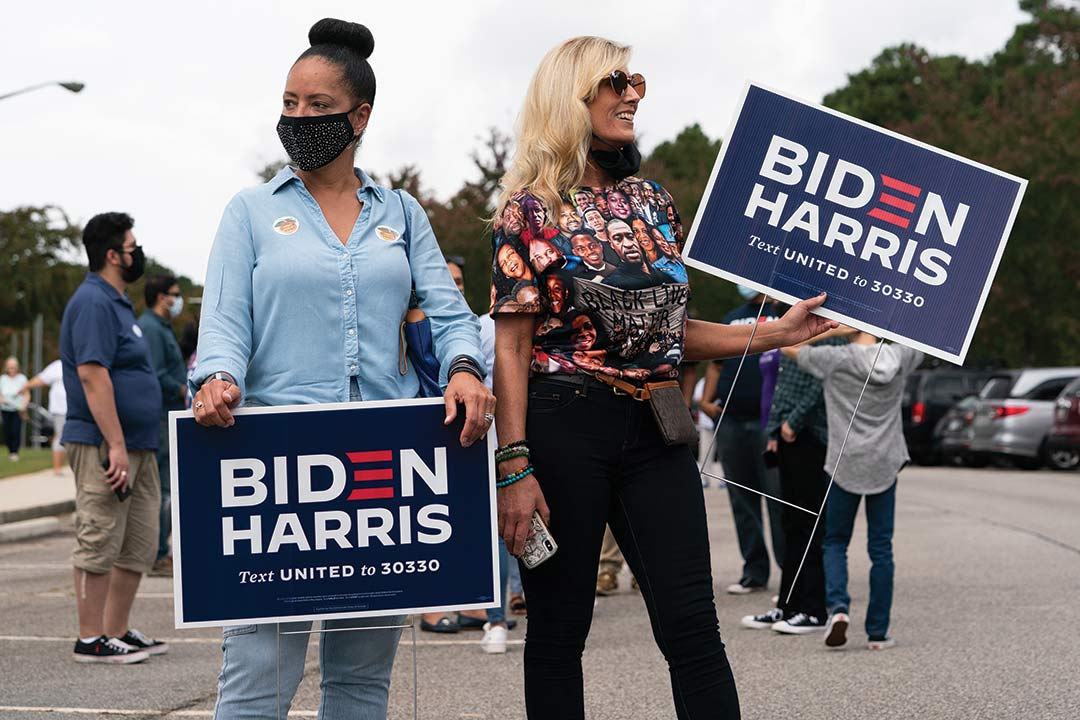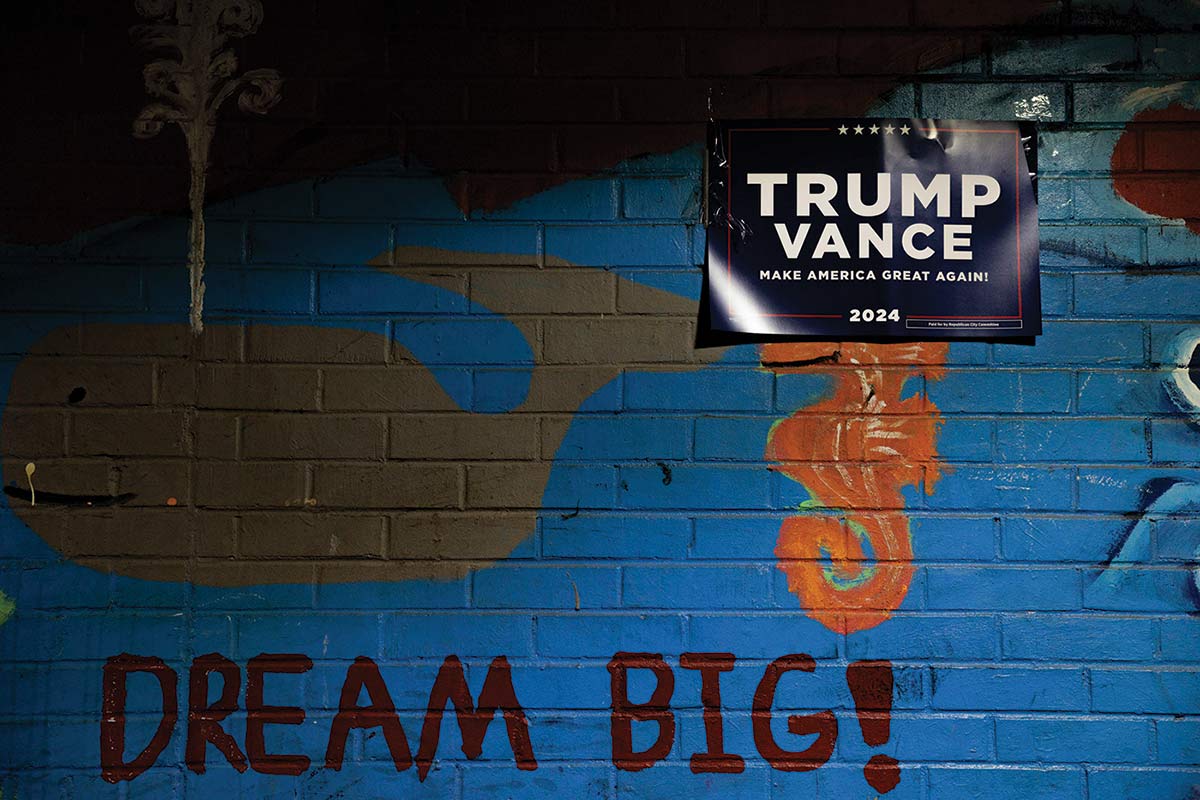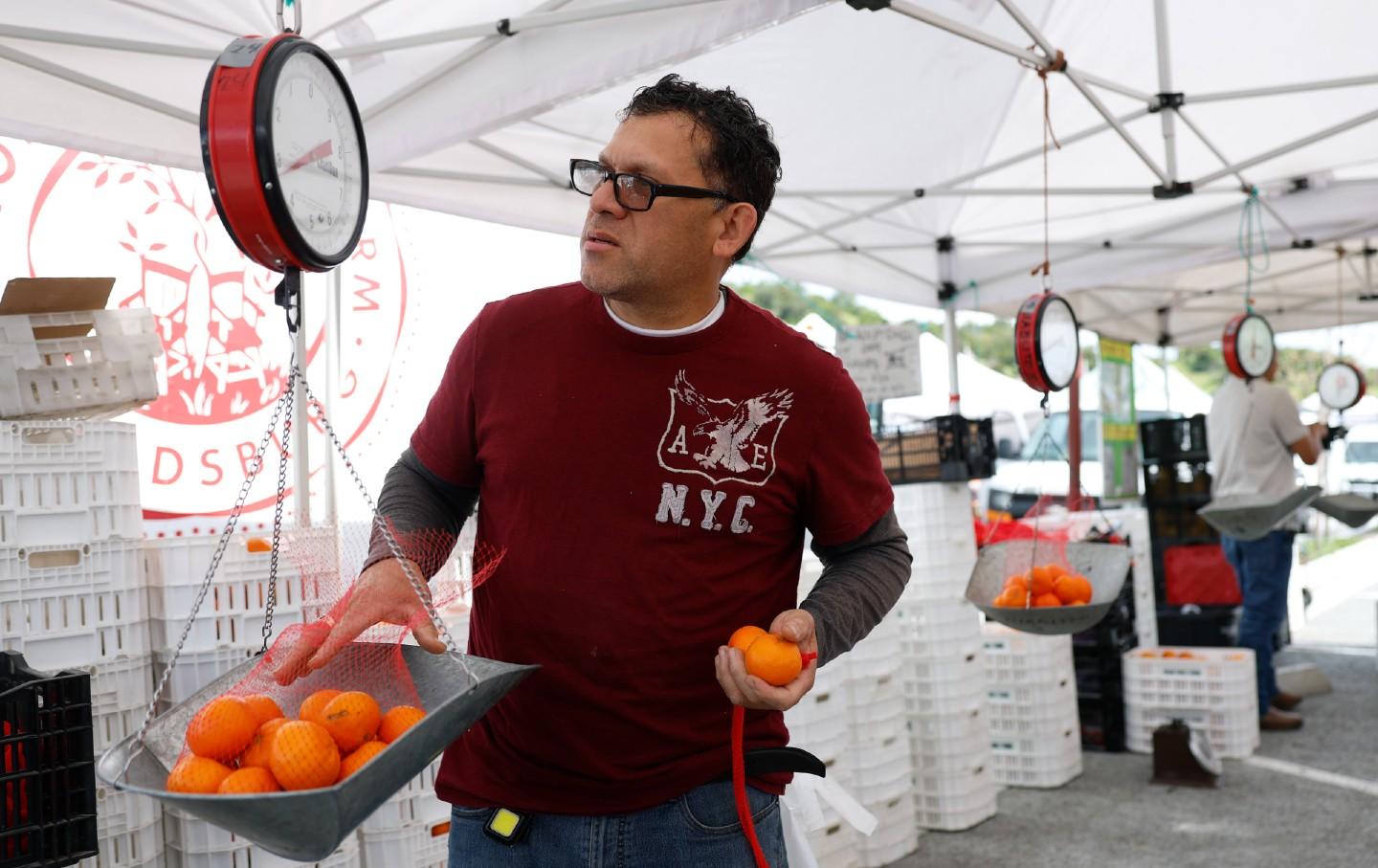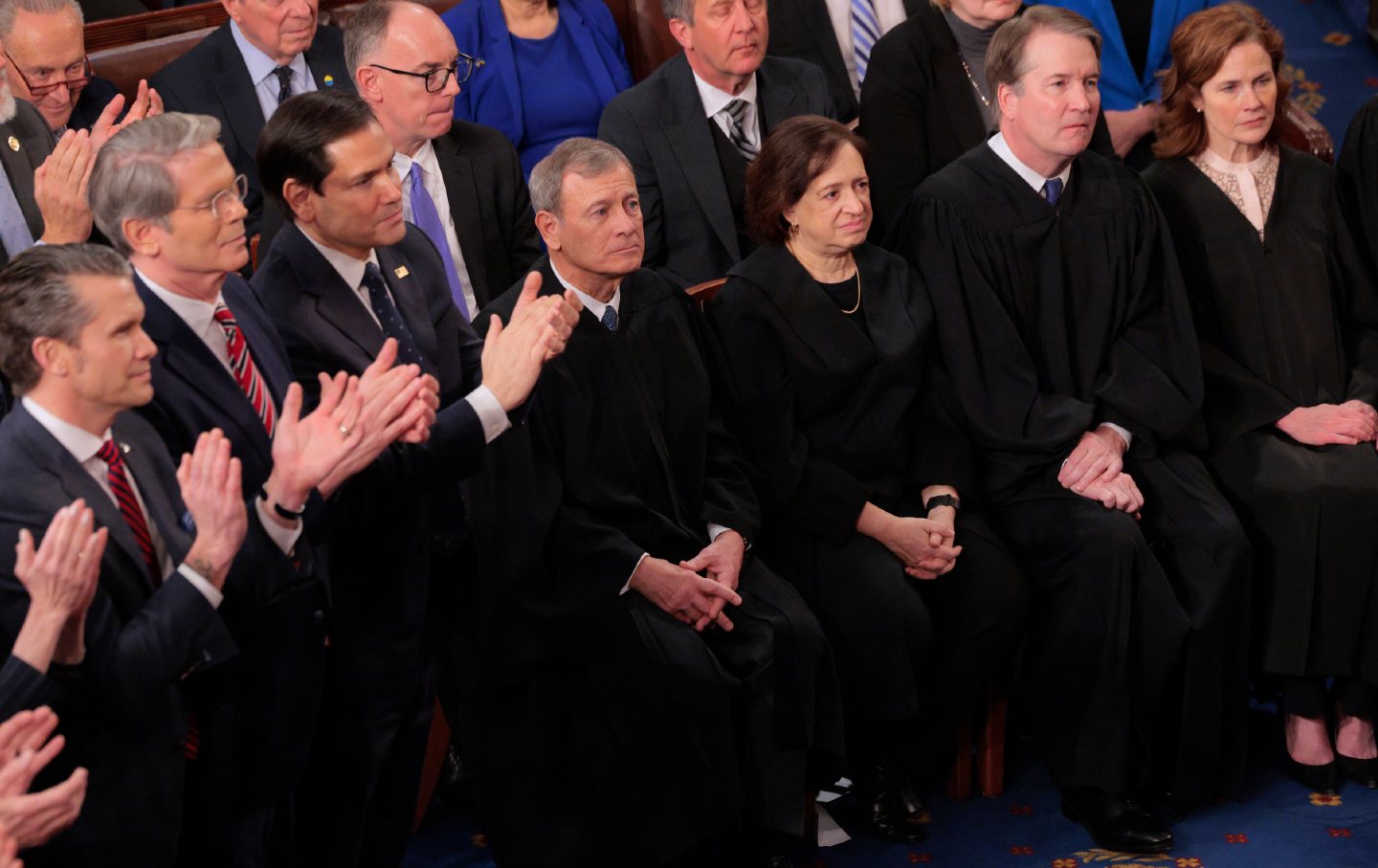The Democrats’ Lost Millions
The people who really decided the 2024 election are the ones who didn’t vote at all—and they could hold the key to a Democratic comeback.

If Democrats are serious about learning from Kamala Harris’s defeat, they should start by rejecting every election postmortem blaming “wokeness” for her loss. Ignore party grandee James Carville’s lashing out at what he derisively mislabeled as the Democrats’ “identity shit.” Print out—then soak in gasoline and set aflame—the memo by Seth London, adviser to rich Democratic donors, demanding a “complete rejection of race-and-group-based identity politics” in favor of “a politics centered on delivering the American dream through simple, concrete action.” What, with all due respect, the fuck are these people talking about?
Harris already ran the “un-woke” campaign her critics wanted. Her downplaying of race and gender was so pronounced, it became a theme of campaign reporting. She bent over backwards to court “Cheney Republicans” and other supposed swing voters. In the end, less than 6 percent of self-identified Republicans voted for her.
Donald Trump, meanwhile, campaigned on fighting the “anti-white feeling in this country,” migrants having “bad genes,” “transgender insanity” in schools, the benevolent sexism of “whether the women like it or not,” and the falsehood that Harris “happened to turn Black.” He cut deep into the country’s divides—but the presumed normalcy of whiteness and maleness lets this form of identity politics go unchallenged. Hence Democrats’ tired vilification of identity politics as a way to cater to the identities this country has always valued most. As always, the Democrats’ takeaway is to scapegoat the marginalized communities that form the party’s core while chasing voters who fled the party as the ink was drying on the 1964 Civil Rights Act.
“There’s no demonstrable evidence that the Democratic Party will win the white vote. They have not for a long time,” said Aimee Allison, the founder of She the People, a national organization that builds political power for women of color. “Why can’t we accept that?”
The Democrats’ takeaway from Trump’s victory should be that a party’s political priorities must resonate with the identities of its base. But they have fundamentally misunderstood this assignment, yet again.
The consequences of that misunderstanding—or refusal to understand—were reflected in 2024’s turnout, when, by some estimates, a staggering 19 million people who voted for Joe Biden in 2020 stayed home. It’s not that Dem voters became Republican en masse this election. In fact, in “nearly a third of the top 50 counties that flipped from Democrat to Republican, Trump’s vote actually declined from his 2020 numbers,” writes Steve Phillips, of both The Guardian and this magazine. Trump increased his vote total by just 2.8 million over 2020. The far bigger problem was Harris’s nearly 7 million vote shortfall compared with Biden four years ago.
“If those people had shown up, particularly in some key areas, 230,000 votes get added in Michigan, Wisconsin, and Pennsylvania, and Kamala Harris is president right now,” the University of Texas historian Jeremi Suri, author of Civil War by Other Means, told me.
It’s also a matter of who stayed home. Politico’s analysis of 3,000 precincts in the largest cities in six battleground states—Atlanta, Milwaukee, Las Vegas, Philadelphia, Phoenix, and Charlotte, North Carolina—found that “the greatest decline in voter participation in all six appears to be in predominantly low-income Black and Hispanic neighborhoods.” In Michigan, turnout increased 2.6 percent overall but declined by 4 percent in Detroit, especially in the city’s majority-Black northern precincts. (At least 22,000 Arab and/or Muslim voters also abandoned Harris in the state, presumably over the war in Gaza.) So, while Harris won Black Michiganders handily (89 percent) and at nearly the same supermajority levels as Biden (92 percent), the shrunken Black voter turnout in those areas “meant that for every 10 voters who did not participate, Harris was losing nine votes while Trump was losing only one,” according to NBC News. What’s more, in the 476 majority-Black precincts in Politico’s study, turnout fell by an average of 6.1 percent—more than double the 2.7 percent citywide average declines. Even in cities where Harris came out on top—such as Chicago and Charlotte—the largest downturns were in Black and other non-white neighborhoods. (The white vote, by contrast, increased for the first time since 1992.) The old truism about elections being decided by those who show up is, particularly for Democrats, still true.
Every four years, our politics come to revolve around the elusive “swing voter,” who is presumed to be white, right-leaning, and moderate. Democrats spend untold amounts of time and money chasing this cohort, and the media spends equally large amounts of time covering it.
But these numbers prove that the real swing voters aren’t white independents who switch parties every four years. They’re voters who swing between going to the polls and staying home—and they are disproportionately from groups that form the Democratic base. That’s why Democrats’ lack of commitment to that base—and, by extension, to multiracial democracy—is a fatal mistake.
That base includes the 86 percent of the country’s multiracial LGBTQ voting bloc who chose Harris, a 22-point jump over the 64 percent who voted for Biden. While Trump certainly made inroads with Asian and Latino voters, especially Latino men, Harris still won the majority of both, 55 and 51 percent respectively. (Other polling from Latino-focused organizations puts Hispanic male support for Harris at 56 percent.) The base also includes the 86 percent of Black voters who chose Harris, including nearly eight in 10 Black men and 92 percent of Black women.
The lack of curiosity about these voters’ choices reflects an assumption that white voters are thoughtful actors making discerning political choices, while voters of color are rote and unthinking. It also lends itself to the neglectful treatment that helped cost Democrats the election.
“Kamala Harris lost because we haven’t given our full focus to these groups that have the largest potential—which are voters of color,” Allison told me. “We haven’t maxed out the Black vote. We haven’t fought for the Latino vote. We have not fully funded and leaned into a strategy which says people of color plus progressive whites are the winning coalition.”
This isn’t about chasing well-off, college-educated white liberals at the expense of anyone else. It’s about a coalition that spans race and class, uniting white liberals and working-class voters of all races who share economic and social priorities. It is entirely possible to forge a political movement that not only honors diverse identity groups but also creates solidarity across difference—and then gets those groups to the polls. This isn’t pandering; it’s strategy. It’s also how you build a movement that can win elections and maybe even change things for the better.
“We have not seen that since Barack Obama,” Allison added. “And Barack Obama was the proof that it could happen.”

All in all, nearly 90 million people didn’t vote in the 2024 election. That’s roughly 36 percent of eligible voters—more people than voted for either Harris or Trump, and in line with rates of nonparticipation going back nearly a century. Studies have found that almost half of Americans are inconsistent in whether they show up to vote from one presidential election to the next. There are also chronic nonvoters, who have voted in, at most, only one of the past six national elections. Sixty-two percent of them have less than a college degree, and 44 percent earn $50,000 or less. (According to the Census Bureau, in 2023 the median income for non-Hispanic Black households was $56,000, while for non-Hispanic white households it was $89,000.) These are the Americans most likely to agree with sentiments such as “No matter who wins, nothing will change for people like me” and “The system is too broken to be fixed by voting,” according to a 2020 poll by FiveThirtyEight. An exhaustive study of those nonvoters, by the Knight Foundation in 2020, found that while 65 percent are white, people of color comprise a greater portion of the nonvoters than of the active voters. There’s also a relatively even distribution of Republican- and Democratic-leaning nonvoters. In our era of razor-thin elections, activating even some of these voters could pay huge dividends.
Studies have repeatedly failed to find that TV and online ads, robocalls, or postcards boost turnout or sway voters in any real sense. A 2017 study from political scientists David Broockman and Joshua Kalla estimated that campaign ads had—wait for it—zero effect on voting decisions.
Instead, research dating back to 2000 shows that the most effective way to get people to the polls—including chronic nonvoters—is with direct personal contact. Even a single in-person conversation with potential voters can increase turnout by up to nine points, according to political scientists Alan Gerber and Donald Green. But these conversations need to be “high-quality,” as Broockman and Kalla put it—not rote deployments of canned lines.
Political scientist Melissa Michelson wrote in 2020 that “for low-income citizens of color, it is very rare to have someone knock on the door for the sole purpose of urging them to vote. When such an unexpected interaction occurs, it can be very meaningful.” The effect can also be contagious, increasing turnout among other household members by as much as 60 percent. The Harris campaign, though, took a traditional approach—one centered around targeting presumed “likely voters” with expensive ads. Most of the more than $1 billion Harris raised was spent on advertising. Salon found that ad buys cost the campaign nearly $700 million; outside groups spent a staggering $2.5 billion on ads.
But, as a string of reports show, even that outreach was hampered by the Democrats’ apparent lack of interest in their base. In September, NOTUS reported that while Biden’s 2020 campaign had spent over $70 million on Black media, the Harris campaign was on track to spend “considerably less.” (Harris, the outlet said, had instructed her staff to increase funding, but with little response.)
In October, a number of Democratic groups warned that Future Forward—the largest reservoir of outside money in support of Harris—was underfunding digital ads and grassroots outreach to non-white and young voters, according to The New Republic. And The Wall Street Journal reported that “Democrats focused on targeting voters of color said they were especially frustrated with the group’s unwillingness to heed their warnings.”
“The Latino orgs were more underfunded than ever before [in 2024],” Chuck Rocha, a Democratic strategist who focuses on Latino voter mobilization, told me. “Why would you leave out those groups? It’s because…all of the money from the donors was told to go through one presidential super PAC.”

When decisions are made by consultants, politicians, and millionaire donors who rarely seek outside perspectives, it’s no surprise that the party’s base gets overlooked. In September, The New York Times’ Maya King wrote that groups focused on minority voter outreach, including “canvassing operations in battleground states,” had warned against the “false belief among some backers that Ms. Harris, who is Black and Indian, will galvanize voters of color without the need for persuasive messaging.”
“The thinking was that Black voters would just turn out because Kamala is a Black woman. It doesn’t work like that,” Keith McCants, the Democratic Party chair in a Georgia county with a significant Black population, told Barn Raiser, an outlet focused on rural communities.
Popular
“swipe left below to view more authors”Swipe →Harris’s much-touted ground game “largely missed grassroots Latino and Black communities,” Voto Latino president Maria Teresa Kumar wrote in an op-ed. The 2024 American Electorate Voter Poll found that 42 percent of Black voters said they hadn’t been contacted by either the Trump or Harris campaign—a sharp jump from 2020, when just 33 percent of Black respondents said they hadn’t been contacted.
Astonishingly, there are indications this was, at least in some cases, intentional. A New York Times postelection investigation, for instance, reported that higher-ups in the Harris campaign instructed organizers “not to engage in the bread-and-butter tasks of getting out the vote in Black and Latino neighborhoods” in Philadelphia. (Harris higher-ups also directed campaign staff to mark as “no response” potential voters who told them Gaza was an issue, according to NBC News.) The staffers eventually went rogue, creating a secret operation focused on Black and Latino communities, without permission from the campaign.
”I’ve heard story after story through my networks of people on the ground whose job it is to turn out voters of color, particularly Black voters, who were not being heard by the campaign. They were getting late money. They were getting no money. The billion dollars went somewhere. But it didn’t go to communities of color,” Allison, whose group neither receives nor solicits support from the Democratic Party, told me.
There were other missteps. The Harris campaign rejected a $10 million proposal by the Congressional Black Caucus, which would’ve included sending members on a bus tour through swing states to engage undecided Black voters, according to Politico. A memo reviewed by the outlet stated that the plan would also have included collaborative work with Latino and Asian American and Pacific Islander groups that are “accustomed to building mulitracial coalitions to win elections.”

It’s impossible to quantify how much these individual decisions harmed Harris. But when you add all of these stories up, you’re left with more and more evidence that Democrats, through neglect or perhaps, more perversely, by design, left potentially gettable voters of color on the table—especially working-class voters. And when you consider this level of negligence toward people the party thought were likely to vote, it’s no wonder that so many nonvoters who might have been activated by the campaign simply dropped out of sight. Politico’s analysis of 2024’s Democratic drop-off found a “split along income and educational lines,” with greater downturns in Black neighborhoods “where residents have the lowest incomes and are least likely to be college-educated.” More specifically, in the poorest Black neighborhoods, “where most households make less than $50,000 per year, turnout dropped 7 percent. In higher-income [Black] precincts, the decline was 4 percent. Similar gaps exist among precincts with varying education levels.”
Rocha was a senior adviser to Ruben Gallego, who won a Senate seat in Arizona, a state that Trump won handily. He noted that many of the nine Republican-held House seats that flipped to Democrats are in districts with sizable Latino populations. He said that’s partly due to the fact that the Democratic Congressional Campaign Committee and the House Majority PAC “hired almost all Latino teams to work on these races” instead of “overeducated white consultants.”
“There’s no people from working-class backgrounds working in campaigns. And there are no Black or brown folks running campaigns at the Senate, governor, or House level, unless you’re intentional,” Rocha said.
On the surface, such basic failures can seem puzzling. But they come from a line of thinking epitomized by the Carvilles of the world: that courting Black and brown people—both voters and nonvoters—is less important than attracting white moderates. As long as Democrats accept this twisted denigration of identity politics—until they genuinely speak to the identities within their multiracial base in a way that resonates—the right will succeed by exploiting identity in the ugliest of ways. The problem isn’t identity politics itself, but who controls the narrative and to what end.
Utilizing identity politics isn’t about reducing people to their race, gender, or sexuality. It’s about recognizing, and speaking to, the ways identity intersects with entrenched economic and social realities. This doesn’t distract from “real issues.” For plenty of marginalized groups, the way institutions and systems respond to their identities is a very real issue; their existence is itself politicized, and thus deserves political attention. Identity politics aren’t a diversion. They’re actually essential to any hope we have of addressing inequality.
Democrats have long tiptoed around this reality, chasing some elusive “middle” instead of directly engaging the communities that make up their base. But history proves that ignoring identity doesn’t erase inequality—it just defers to power. Vague calls to unity mean nothing. But you know what does? Fully supporting policies that acknowledge the specific struggles of marginalized communities and include them in a shared vision for the future.
“We have a lot of people for whom identity is a very important part of what animates our politics. Why are we hedging? Lean into it loud and proud,” Allison told me. “The way we heard white nationalist rhetoric from Trump and MAGA? They leaned heavily into the worst kind of identity politics. But there is a far better, more inclusive, more representative alternative.”
We saw this in 2020. Black women organizers, especially in the South, were finally recognized for the years of tireless, thankless groundwork they had laid to ensure a Democratic presidential victory. Georgia not only swung to Biden but also handed Democrats the Senate. The many Black women organizers who had carried this heavy load—like Aimee Allison, LaTosha Brown, and, most prominently, Stacey Abrams—were hailed as heroines in endless, borderline-patronizing retrospectives.
In a prescient 2019 Foreign Affairs article, Abrams defended identity politics as a political tool for reaching marginalized voters in “recognition of their specific policy needs.” Citing her 2018 campaign for governor—which, though unsuccessful and marred by allegations of GOP chicanery, gave Georgia Democrats their highest vote share in 20 years in a statewide race and presaged Biden’s win—Abrams wrote that she “championed reforms to eliminate police shootings of African Americans, protect the LGBTQ community against ersatz religious freedom legislation, expand Medicaid to save rural hospitals, and reaffirm that undocumented immigrants deserve legal protections. I refused to accept the notion that the voters most affected by these policies would invariably support me simply because I was a member of a minority group. (The truth is that when people do not hear their causes authentically addressed by campaigns, they generally just don’t vote at all.)”
Biden won in 2020 by turning out the most demographically diverse voter base in Georgia’s history. As Abrams wrote in a Democracy Docket article, citing figures from the data firm TargetSmart, “Turnout among black voters increased by about 20 percent; Hispanic voter participation soared by 72 percent; Asian-American turnout nearly doubled when compared to the 2016 election; and turnout among voters under the age of 30 also increased sharply, growing from about 14 percent of ballots cast to about 16 percent.”
“The way that I’ve seen activism work and be sustained is that you do it with community. And you do it consistently,” Palak Sheth, a cofounder of Post March Salon and an organizer of the South Asian Women for Harris Zoom call, told me. “And let’s be very clear—the people that are doing the work, when we talk about getting out the vote, are largely women.”
This kind of perennial presence in communities goes beyond elections, intertwining political influence with everyday life.

It would be impossible to achieve 100 percent voter turnout in this country. Even if it were possible, not every voter would support Democrats. Still, there remains a vast pool of untapped potential among so-called nonvoters or “unlikely” voters. Daniel Laurison, a sociologist and the author of Producing Politics, writes that the “prevailing idea among politicos about this group is that they are hopeless targets for campaigns.” Instead, campaigns pour resources into winning over “undecideds” and “independents,” despite studies finding that all that money has little to no impact. (There is a reason political scientists refer to independents as “closeted partisans.”) But nonvoters and infrequent voters were among those mobilized by Abrams and others.
Democrats could seize this opportunity, but it would require a kind of commitment they have rarely shown. Instead of selectively investing in Black and other non-white communities during election seasons, they would need sustained, year-round engagement. That means funding grassroots efforts of women of color who are doing the legwork once undertaken by civic organizations, building relationships beyond voter turnout drives and nonstop fundraising.
The potential is huge—when campaigns lean into identity, it resonates deeply. As Allison noted, an August 2024 Fairleigh Dickinson University study found that when voters were unknowingly “primed to think about race and gender,” they showed increased support for Harris. If Democrats would stop allowing “identity politics” to be wielded as a critique, and instead embraced it in a way that was authentic and persistent, it could be truly transformative.
That would mean genuinely promoting policies that materially improve the lives of Black and other non-white voters, LGBTQ folks, and, yes, working-class white voters, too. It would also mean refusing to retreat from those policies in an effort to win over a voting bloc that will never support Democrats. And, it cannot be stressed enough, it would also mean engaging supporters outside of the campaign cycle.
The right’s ground game feeds into church networks, media ecosystems, and college groups—all spaces that reinforce belonging year-round. Democrats should be doing the same, embedding in the places where supporters live, work, and socialize, ensuring that identity-driven outreach isn’t just cynically performative but woven into the heart of their political movement. This work happens at the grassroots community level. The party should support it in every way, including with its dollars.
Conventional wisdom, even when repeatedly proven ineffective—combined with good old white supremacy—quashes innovation and risk-taking. But campaigns are more than just political operations; their messaging reverberates beyond the ballot box, shaping the broader culture.
A retreat from advocacy for equality and justice, which is exactly what so many Dems are suggesting is the “safe” path right now, doesn’t just weaken the political fight—it signals that those values are negotiable.
The reports about the Harris campaign’s priorities and expenditures suggest that much of what was learned from the success of Abrams and other organizers in 2020 has already been forgotten.
As if on cue, in November 2023, The New York Times reported that organizers in Georgia were warning about a return to form among moneyed Democratic Party forces, with donors pulling back funds. In January 2024, the Times reported that Fair Fight, the Abrams-founded voting rights organization, was “laying off most of its staff and scaling back its efforts in response to mounting debts incurred by court battles.”
That does not bode well. Neither does a March 2025 report from Politico about a group of “moderate Democratic consultants, campaign staffers, elected officials and party leaders” who gathered that February to chart the party’s future—but instead drafted a backward-looking blueprint for its demise. The strategy included proposals to “embrace patriotism,” “be more accepting of masculinity and male voters who feel alienated from the party,” and, at the top of the list, “move away from identity politics.”
Billed as a “Comeback Retreat,” the whole event was hosted by the aggressively centrist Third Way, a think tank bankrolled by corporations, billionaires, and finance titans that spends most of its time attacking progressives. It would have been less time-consuming to draft a memo that simply said “Merge with MAGA,” but I guess everyone enjoys a nice off-site.
“All these [media] firms who dramatically underperformed with Kamala Harris and Joe Biden are now being hired to run every Senate and governor’s race around the country. We keep doing the same thing over and over again, hoping that we get different results,” Rocha, the Democratic strategist, told me. “And we will—Donald Trump’s going to tank the stock market. The Consumer [Price] Index is at an all-time high. Unemployment’s going to start going up. Democrats are going to win elections in the midterms. And all of these consultants will think they’ve got it all figured out, when they have no idea.”
Allison, meanwhile, like so many other underfunded and underappreciated political activists and organizers, is tired.
“There’s a point at which Black women like myself and many, many, many, many others who have been critical to recent wins, gains, expanding of the electorate, and winning statewide contests are feeling the need to step back,” Allison said. “The party has not leaned fully into Black women’s leadership. And so that’s, to a lot of us, a signal that the people that still hold the purse strings have no intention of changing. They’d rather lose, make money, and keep this insanity going. It makes no sense to me.”
Hold the powerful to account by supporting The Nation
The chaos and cruelty of the Trump administration reaches new lows each week.
Trump’s catastrophic “Liberation Day” has wreaked havoc on the world economy and set up yet another constitutional crisis at home. Plainclothes officers continue to abduct university students off the streets. So-called “enemy aliens” are flown abroad to a mega prison against the orders of the courts. And Signalgate promises to be the first of many incompetence scandals that expose the brutal violence at the core of the American empire.
At a time when elite universities, powerful law firms, and influential media outlets are capitulating to Trump’s intimidation, The Nation is more determined than ever before to hold the powerful to account.
In just the last month, we’ve published reporting on how Trump outsources his mass deportation agenda to other countries, exposed the administration’s appeal to obscure laws to carry out its repressive agenda, and amplified the voices of brave student activists targeted by universities.
We also continue to tell the stories of those who fight back against Trump and Musk, whether on the streets in growing protest movements, in town halls across the country, or in critical state elections—like Wisconsin’s recent state Supreme Court race—that provide a model for resisting Trumpism and prove that Musk can’t buy our democracy.
This is the journalism that matters in 2025. But we can’t do this without you. As a reader-supported publication, we rely on the support of generous donors. Please, help make our essential independent journalism possible with a donation today.
In solidarity,
The Editors
The Nation








